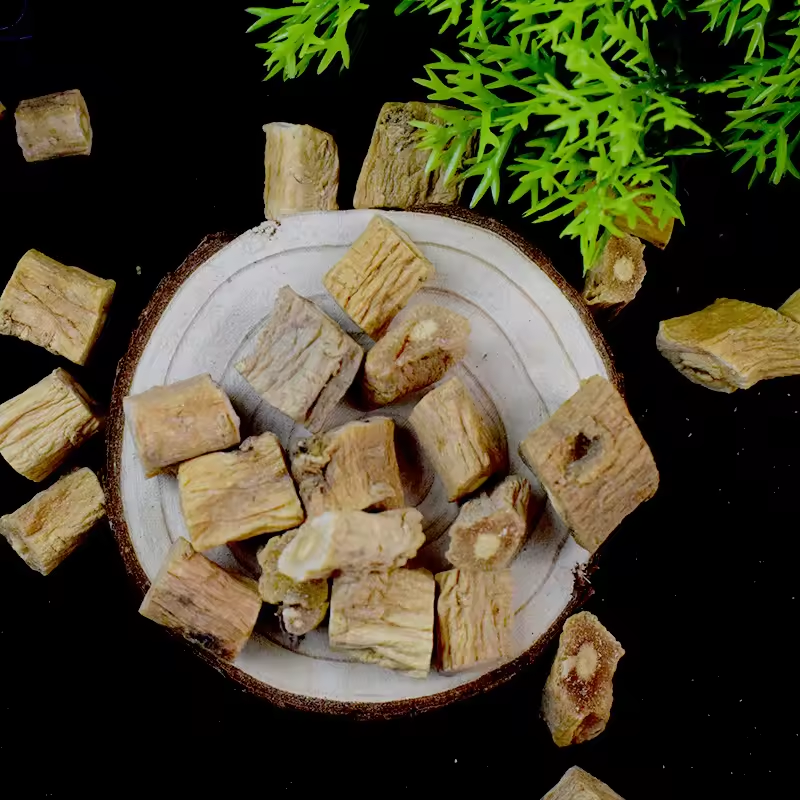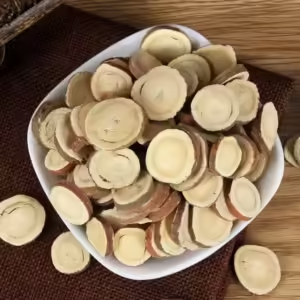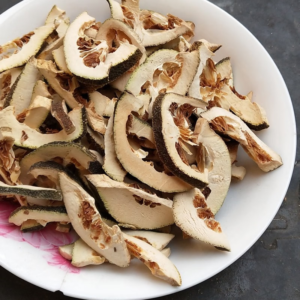党参は、キキョウ科の党参、党参、党参の根を乾燥させたもので、気を補う薬です。
ツルニンジンは甘味があり、平たい性質で、脾臓と肺の経絡に入ります。
人参は甘くて平らで、乾燥しておらず、脂っこくなく、脾臓と肺の経絡に入ります。気を補う力は高麗人参に劣り、主に脾臓と肺の気虚の軽い症状に使用されます。また、体液を生成し、血液を養う働きがあり、体液不足や血不足などの症状を治療できます。
この製品には主にコドノシド、グルコース、イヌリン、多糖類、ツルニンジンアルカロイド、揮発性油、フラボノイド、植物ステロール、微量元素などの成分が含まれています。
ツルニチニチソウの主な薬効部位はどこですか?
コドノプシス・ピロスラの薬効成分:
キキョウ科の Codonopsis pilosula (Franch.) Nannf.、Codonopsis pilosula Nannf.var.modesta (Nannf.) LTShen、または Codonopsis tangshenOliv. の乾燥した根。Codonopsis の薬用部位の形状特性:
コドノプシスは長い円筒形でわずかに湾曲しており、長さは10~35cm、直径は0.4~2cmです。
表面は灰黄色、黄褐色から灰褐色で、根頭には多数のいぼ状の茎痕と芽がある。茎痕の上部は凹んで点状で、根頭の下には密な環状横縞があり、下に行くほど次第にまばらになり、全長の半分に達するものもある。栽培品は環状横縞がほとんどないか全くなく、全体に縦じわがあり、長い皮目状の突起が散在し、折れた根には暗褐色の膠質が付着していることが多い。
肌理はやや軟らかく、またはやや硬くやや強靭で、断面はやや平らで、亀裂または放射状の組織があり、木肌は淡褐色から黄褐色、材色は淡黄色から黄色です。独特の香りがあり、味はやや甘いです。
蘇花芍薬(西洋芍薬)は長さ10~35cm、直径0.5~2.5cmで、表面は黄白色から灰黄色で、根頭下の密集した環状の横縞は全長の半分以上に達することが多い。断面には亀裂が多く、表皮は灰白色から薄茶色である。四川芍薬は長さ10~45cm、直径0.5~2cmで、表面は灰黄色から黄褐色で、縦溝が不規則で明瞭である。質感は柔らかくてしっかりしており、断面の亀裂は少なく、表皮は黄白色である。
コドノプシスは古代の書物にどのように記録されているのでしょうか?
『本芍風園』:「上当人参は甘温滋養の作用はないが、甘平滋養の力があり、寒性で肺気を流すことに特化した梔子とは異なります。
「本草叢心」:「滋養強壮、気、脾胃、喉の渇きを解消します。中気はやや弱く、調整と補給に使用され、非常に安全です。」
『本草綱木詩義』:「肺虚を治療し、肺気を助ける。
『本草正益』:「当神は脾胃を養い、肺を潤して津液を生成し、中気を強める。これは高麗人参に遠く及ばない。特に貴重なのは、脾肺を強めて乾かず、胃陰を養って湿らず、肺を潤して冷さず、血を養って脂っぽくなく、清陽を元気づけ、中気を震わせて硬く乾かないことである。」
効果と機能
当神には脾臓と肺を強化し、血液を養い、体液を生成する機能があります。
コドノプシスの主な効果と臨床応用は何ですか?
当参は、脾肺気虚、食欲不振による疲労、咳、虚弱喘息、気血不足、顔色悪し、動悸、息切れ、体液喪失による喉の渇き、内熱、喉の渇きなどに用いられます。
脾肺気虚症候群:
· 体力の低下や疲労、食欲不振、軟便などの症状を伴う脾気虚を治療し、しばしば枸杞子や枸杞子と併用します。
息切れ、声の弱さ、咳、弱い喘息などを伴う肺気虚を治療し、黄耆や五味子と併用することができます。
気血虚および気水虚症候群:
気血虚による顔色蒼白、めまい、動悸、手足の倦怠感などの症状に用い、黄耆、当帰、地黄などと併用することが多い。気水虚による喉の渇き、内熱渇きなどの症状に用い、茯苓、五味子などと併用することが多い。
コドノプシス・ピロスラには他にどんな効果がありますか?
肺と脾臓の虚弱による疲労、咳、倦怠感:
党参500g(柔らかくて甘い、スライス)、アデノフォラアデノフォラ250g(スライス)、リュウガンパルプ120g。水で沸騰させて濃縮ジュースを作り、ビーズ状に滴下し、磁器に保存します。毎回ワイングラス1杯を使用し、沸騰したお湯を空にして飲むか、煎じ薬に注ぎます。気血の不足による腰痛、息切れ、動悸、不眠、自発発汗:
ツルニンジン、トウキ、長芋各10g、豚ロース肉500g、醤油、酢、生姜、ニンニク、ごま油適量、
豚ロース肉を切って筋膜と臭腺を取り除き、洗います。洗った当帰、人参、山芋、豚の腎臓を鍋に入れ、適量の水を加え、豚の腎臓が柔らかくなるまで煮込みます。豚の腎臓を取り出し、冷ましてから薄切りにし、平皿にのせ、醤油、酢、千切り生姜、みじん切りニンニク、ごま油などの調味料を加えて食べます。食事と一緒に頻繁に食べます。
疲労感、眠気、頭部や顔面の浮腫、手足の浮腫、食欲不振、軟便:
人参3g、黄耆3g、鶏胸肉200g、冬瓜1kg、塩、日本酒などを適量。
人参と黄耆を洗い、鶏肉を細切りにし、冬瓜の皮をむいて横に切ります。冬瓜をスープボウルに入れ、細切りにした鶏肉、人参、黄耆、塩、日本酒、グルタミン酸ナトリウムを冬瓜の上に乗せ、適量の水を加えます。冬瓜のボウルを蒸し器に入れて蒸し、火が通るまで煮ます。食事と一緒に頻繁に食べます。
コドノプシスを含む複合製剤は何ですか?
布中易気丸:
附中易気、瀉阳は沈下を持ち上げます。脾胃の衰弱と中気の沈下によって引き起こされる下痢、直腸脱、子宮脱に使用されます。症状には、疲労、食欲不振、腹部膨張、軟便、慢性下痢、肛門脱または直腸脱、子宮脱などがあります。
利中丸:
中を温めて寒を取り除き、胃を強化します。脾胃虚弱、寒、嘔吐、下痢、胸膨満、腹痛、消化不良などに用いられます。神水丸:
気を補って症状を緩和し、風寒を消し、痰や咳を和らげます。風寒による体力低下や風邪に用いられます。症状としては、嫌寒・発熱、頭痛・鼻づまり、咳・痰、胸苦しさ・嘔吐、疲労・息切れなどがあります。
バゼン丸:
気血を補う。気血虚、顔色悪し、食欲不振、手足の疲労、月経過多などに用いられる。乾皮丸:
脾臓を補い、食欲を増進します。脾胃虚弱、腹部膨満、食欲不振、軟便などに用いられます。
ブピ・イーチャン丸薬:
気を補って血を養い、陽を温めて気を高め、腸を収斂させて下痢を止める。脾虚、気鬱滞による下痢で、腹部膨満、疼痛、腸鳴り、下痢、便に粘血などの症状を伴うもの、また上記症状を伴う慢性大腸炎、潰瘍性大腸炎、アレルギー性大腸炎に用いられる。
神奇経口液:
気力を補い、体を強くします。虚弱体質や気虚、手足の衰弱などに用いられます。
コドノプシス・ピロスラに関する最近の研究の進歩
本品は、身体の適応力の強化、免疫機能の強化、老化の遅延、抗潰瘍、鎮静、鎮痛、睡眠促進、学習・記憶機能の改善、赤血球・ヘモグロビンの増加、抗菌、抗炎症、抗腫瘍補助などの多様な薬理効果を有します。
使用方法
党参には、脾臓と肺を強化し、血液を養い、体液を生産する機能があります。煎じ薬として服用したり、水、お粥、スープなどで煮て服用することができますが、どの方法を使用するにしても、医師の指示に従って服用する必要があります。
コドノプシス・ピロスラを正しく使用するには?
ツルニンジンを経口摂取する場合、通常9~30gを摂取します。
生のまま体液を生成し、血液を養うのに適しており、焙煎して脾臓と肺を補うのに適しています。調製方法が異なれば効果も異なりますが、使用方法は同じです。具体的な使用方法については、医師のアドバイスに従ってください。党参は一般的に煎じ薬として使用され、煎じて服用するか、粉末または丸薬に加工します。ただし、漢方薬の使用は、必ず病状の鑑別と治療に基づいて行われ、専門の漢方医の指導の下で使用する必要があります。勝手に使用したり、漢方薬の処方や広告を聞いたりして勝手に使用したりしないでください。
また、コドノプシスは日常の健康管理にも活用できます。一般的な摂取方法は次のとおりです。
· お粥(神霊粥):党参、茯苓、生姜各10gと白米100gを炊きます。まず、3つのハーブを水で煮て汁を抽出し、米を加えてお粥にします。塩を加えて味付けすることもできます。党参と茯苓は胃を養い、生姜は中を温めて胃を強くし、嘔吐を止め、白米は脾臓を養い、胃を養います。脾臓と胃が弱い、食欲不振と嘔吐、体重減少と疲労などの症状に使用されます。
スープ(東参とアスパラガスの大根煮込み):党参とアスパラガスをそれぞれ20g、大根を500g(みじん切り)用意します。党参、アスパラガス、大根を鍋に入れ、適量の水を加え、強火で沸騰させ、弱火で30分間煮込みます。1日1回、大根150gを食べます。腎臓と肺に栄養を与え、咳や喘息を和らげる効果があります。
ワインに浸す:党参をワインに浸すと、脾臓を強化し、気を補充する効果があります。他の漢方薬と一緒にワインに浸すこともできます。
注意:コドノプシスは、熱中症には服用しないでください。
コドノプシスの作り方は?
· 人参:生薬を取り出し、葦の頭を取り除き、洗って湿らせ、厚めに切って乾燥させます。 、米人参:米を取ってフライパンに入れ、中火で米が煙が出るまで加熱し、生の人参のスライスを注ぎ、米が古い黄色になるまで炒め、取り出し、米をふるいにかけ、冷まします。人参100kgに対して、米20kgを使用します。
人参蜂蜜:精製蜂蜜を適量の熱湯で薄め、人参のスライスを加えてよく混ぜ、十分に煮込み、フライパンに入れて弱火で熱し、黄褐色になるまで炒め、粘り気がなくなったら取り出して冷まします。人参100kgに対して、精製蜂蜜20kgを使用します。
コドノプシスと同時に使用すべき薬剤は何ですか?
Veratrum と一緒に使用しないでください。
中医学と中西医学の併用には、症候群の鑑別と臨床個別治療が必要である。
投薬指示
ツルコケモモは性質が平たいですが、甘味と滋養が強いので、暑さ対策には向きません。
コドノプシスを使用する際の注意点は何ですか?
コドノプシスはベラトラムと一緒に使用しないでください。
気滞や怒りのある人には禁忌であり、満腹や火のある人にはタブーである。
妊娠中および授乳中の女性:妊娠中、妊娠を計画中、または授乳中の場合は、早めに医師に連絡し、漢方薬が治療に使用できるかどうかご相談ください。
小児: 小児の投薬は、医師の指導と大人の監督の下で行う必要があります。
医薬品は適切に保管し、ご自身の医薬品を他人に渡さないでください。
コドノプシスの見分け方と使い方は?
高麗人参とツルニンジン
高麗人参と党参には、脾気を補う、肺気を補う、気を補って体液を生成させる、気を補って血を生成する、体を強くして邪気を払うなどの作用があり、脾気虚、肺気虚、体液による渇き、渇き、血不足、気虚邪過剰などに用いられます。
人参は甘くてマイルドな性質で、効き目は穏やかで薬効は弱い。古代の処方では、軽症や慢性疾患の患者は人参を大量に服用して人参の代わりにすることができるが、急性や重篤な疾患には人参が依然として適している。
しかし、ツルコギには人参のような気を補って救う働きはありません。生命力が衰える症状に対しては、人参を使って救うべきであり、ツルコギを代用することはできません。また、人参は気と陽を補い、心を落ち着かせ、知能を高める効果もありますが、ツルコギにも目立たない同様の効果がありますが、血液を補う働きもあります。
患者様から最もよく聞かれる質問
党参と黄耆を水に浸して飲むとどんな効果や働きがありますか?
党参と黄耆を水に浸して一緒に飲むと、中気を補い、脾臓を強化し、肺に利益をもたらす効果があります。同時に、発汗を抑えて体を固め、傷を支えて組織の再生を促進し、利尿を促進して腫れを軽減することができます。臨床の場では、党参と黄耆はしばしば一緒に使用され、相補的な効果があります。一緒にお湯を沸かす効果は、気虚と虚血の患者、つまり体が弱い患者の治療にさらに反映されます。党参と黄耆と一緒に水を沸かしたり、鶏肉やアヒルを煮込んだりするのも良いでしょう。
両剤を併用すると、中気の改善に非常に良い効果があり、重病から回復したばかりの患者や大手術を受けた患者を治療し、エネルギーが満ち溢れ、脂っぽさがあまり出ず、湿気もあまり出ません。一部の患者、特に高齢者にとっては、病気の抑制に非常に有益です。
女性にとってツルレイシを食べることの利点は何ですか?
女性の友人は党参を食べることで気血を補い、血を養い、心を落ち着かせることができます。
長期間にわたってツルニンジンを食べると、血糖値と血圧を下げ、肝臓を保護し、体の免疫力を高め、病気に対する抵抗力を高めることができます。
党参は陽気を強化し、腎臓を補うことができますか?
党参は健康に良い効果がありますが、主な機能は気を強め、心を落ち着かせ、神経を鎮めることです。臨床的には脾臓と肺を強化するために使用されますが、腎臓を強化し、陽を強化する効果はなく、患者の腎虚症状の改善に良い効果はありません。
ハーブ
コドノプシス・ピロスラ – ダンシェン
価格帯: $88.88 – $49,880.00
+ 送料無料コドノプシス・ピロスラ(添付:コドノプシス・ピロスラ)
【科・属・薬用部位】本品は、キキョウ科の植物であるツルニンジンまたはツルニンジンの根です。
【性状・味・経絡】甘味、扁平。脾臓と肺の経絡に入る。
【効能】 附中と気。
【臨床応用】気虚、疲労、息切れ、脾虚、食不足、浮腫、慢性下痢、脱出などの症状に用いられます。
本品は臨床でよく使用される補気薬で、脾臓と肺を養う働きがあり、その効果は人参に似ていますが、効き目は劣ります。気虚のさまざまな疾患に適しており、臨床では黄耆、枸杞、山芋などと組み合わせて使用されることが多く、虚血、黄疸、慢性出血性疾患などによる気血共存の症状には、地黄や当帰などの補血薬と組み合わせて使用することもできます。
| 重さ | 1kg、10kg、100kg、500kg、1000kg |
|---|


















レビュー
まだレビューはありません。